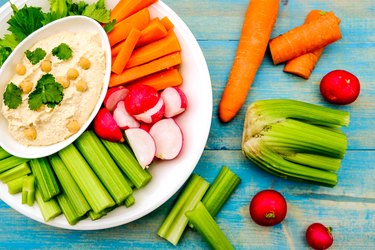
The definition of a calorie is a measurement of energy it takes to raise the temperature of one kilogram of water by one degree Celsius. This may seem complicated, which is why using a calorie calculator is a much simpler way of understanding the calories in vegetables, fruits and other foods.
Some eating plans require a certain amount of calories per day, such as a 1,200 calorie eating plan for weight loss or consuming 5,000 calories a day for weight gain. This is known as either a calorie deficit or a calorie surplus, which are needed for weight loss or weight gain, respectively. If adjusting your body weight is one of your health and fitness goals, knowing the calorie content in the food you eat can be helpful to achieve those goals.
Video of the Day
Video of the Day
Fruits and vegetables are nutrient-dense foods that should be consumed regardless of your weight loss or weight gain goals. They vary in calories, so you may want to consume more or less fruits and vegetables depending on your situation.
Calories in Vegetables
Vegetables are often recommended on low-calorie diets geared toward weight loss because they tend to be low in calories. When foods are low in calories, you can consume a larger volume of them. This fills you up, provides you with vital nutrients and curbs your appetite. If the calories in vegetables are of concern, go for leafy green vegetables that tend to be low in calories.
Low-calorie vegetables include:
- Celery: 6 calories per 1 medium stalk raw
- Spinach: 7 calories per 1 cup raw
- Cucumber: 8 calories per 0.5 cup raw
- Bell pepper: 15 calories per 0.5 cup raw
- Mushrooms: 15 calories per 1 cup raw
The calories in vegetables can also come in handy on weight gain eating plans. When implementing a calorie surplus, focus on vegetables that are higher in calories. These tend to be starch vegetables.
Higher calorie vegetables include:
- Russet potatoes: 168 calories per 1 medium baked potato
- Yellow corn: 143 calories per 1 cup cooked
- Green peas: 134 calories per 1 cup cooked
- Sweet potatoes: 103 calories per 1 medium baked sweet potato
- Parsnips: 100 calories per 1 cup raw
You can adjust the calories in vegetables by preparing them a certain way. Steaming and boiling vegetables tend to yield fewer calories, while frying in oil will increase the calories in vegetables. Condiments, sauces and dips also increase calories in vegetables.
Calories in Fruit
Fruits are mainly consumed raw, so the calories in fruit are more straightforward than vegetables, which have different cooking and preparation methods. The calories in fruit are usually less concerning than the sugar in fruit. However, neither the sugar nor the calories in fruit should deter you from enjoying this nutritious food group.
Fruits that are lower in calories include:
- Clementines: 35 calories per 1 clementine
- Blueberries: 42 calories per 0.5 cup
- Watermelon: 46 calories per 1 cup
- Strawberries: 53 calories per 1 cup
- Grapefruit: 53 calories per 0.5 large grapefruit
Fruits that are higher in calories include:
- Plantains: 179 calories per 1 cup cooked
- Durian: 179 calories per 0.5 cup
- Avocado: 161 calories per 0.5 avocado
- Jackfruit: 157 calories per 1 cup
- Banana: 105 calories per 1 medium banana
Dried fruit, fruit juices and jams and jellies made from fruit are higher in calories because they are concentrated. Unprocessed fruits are lower in calories. Some fruits, such as apples and peaches, are often cooked and incorporated in desserts like pies and tarts. These are likely high in calories, sugar and refined carbs, which may not be ideal for weight loss.
Fruit should not be avoided because of the calorie content. Fruit contains a variety of vitamins and minerals, but many people do not consume enough fruit. According to the Centers for Disease Control and Prevention, only 12 percent of adults consume the recommended amount of fruit. Simple ways to incorporate fruit into your diet include smoothies, fruit salads and parfaits.
Use a Calorie Calculator
If tracking the calories in vegetables and fruits seems time-consuming or intimidating, use a calorie calculator to make this task easier. You may find that you can eat intuitively after using a calorie calculator for a few weeks, so you may become less reliant on a tool to help you track your calorie intake.
Regardless of the calories in fruits and vegetables, you should consume at least the minimum recommended servings of these foods every day. According to the USDA, adults should consume between 1.5 and 2 cups of fruit per day depending on age and gender. The USDA also recommends that adults consume between 2 and 3 cups of vegetables per day.
- USDA Choose MyPlate: “All About the Vegetable Group”
- USDA Choose MyPlate: “All About the Fruit Group”
- Centers for Disease Control and Prevention: “Only 1 in 10 Adults Get Enough Fruits or Vegetables”
- MyFoodData: “Nutrition Facts for White Button Mushrooms”
- MyFoodData: “Nutrition Facts for Green Bell Peppers”
- MyFoodData: “Nutrition Facts for Cucumber”
- MyFoodData: “Nutrition Facts for Spinach”
- MyFoodData: “Nutrition Facts for Celery”
- MyFoodData: “Nutrition Facts for Baked Russet Potatoes”
- MyFoodData: “Nutrition Facts for Parsnips”
- MyFoodData: “Nutrition Facts for Cooked Green Peas”
- MyFoodData: “Nutrition Facts for Cooked Yellow Sweet Corn”
- MyFoodData: “Nutrition Facts for Cooked Sweet Potatoes”
- MyFoodData: “Nutrition Facts for Strawberries”
- MyFoodData: “Nutrition Facts for Watermelon”
- MyFoodData: “Nutrition Facts for Clementines”
- MyFoodData: “Nutrition Facts for Blueberries”
- MyFoodData: “Nutrition Facts for Grapefruit”
- MyFoodData: “Nutrition Facts for Bananas”
- MyFoodData: “Nutrition Facts for Jackfruit”
- MyFoodData: “Nutrition Facts for Avocados”
- MyFoodData: “Nutrition Facts for Durian”
- MyFoodData: “Nutrition Facts for Plantains Cooked”